Last summer, our modest garden surprised us with an abundance of buttercup squash (kalabasa) that started as a single plant and somehow took over an entire corner of the garden. While traditional ukoy usually features shrimp as the star ingredient, I found myself staring at these beautiful squash and wondering: why not let our garden's bounty shine?
After experimenting with a few batches, this Kalabasang Ukoy recipe emerged as a delightful revelation. The natural sweetness of homegrown buttercup squash, combined with carrots from our raised beds and spring onions that seem to multiply by themselves, created fritters that were so satisfying that we didn't miss the shrimp at all. The key was cutting the vegetables uniformly thin - a technique my grandmother always insisted upon for the crispiest results.
What makes this recipe special isn't just its simplicity or the money saved on ingredients, it's the satisfaction of transforming humble backyard vegetables into something that honors Filipino culinary tradition while creating new memories. This vegetarian twist on ukoy proves that sometimes the best recipes come from working with what you have at hand.
Jump to:
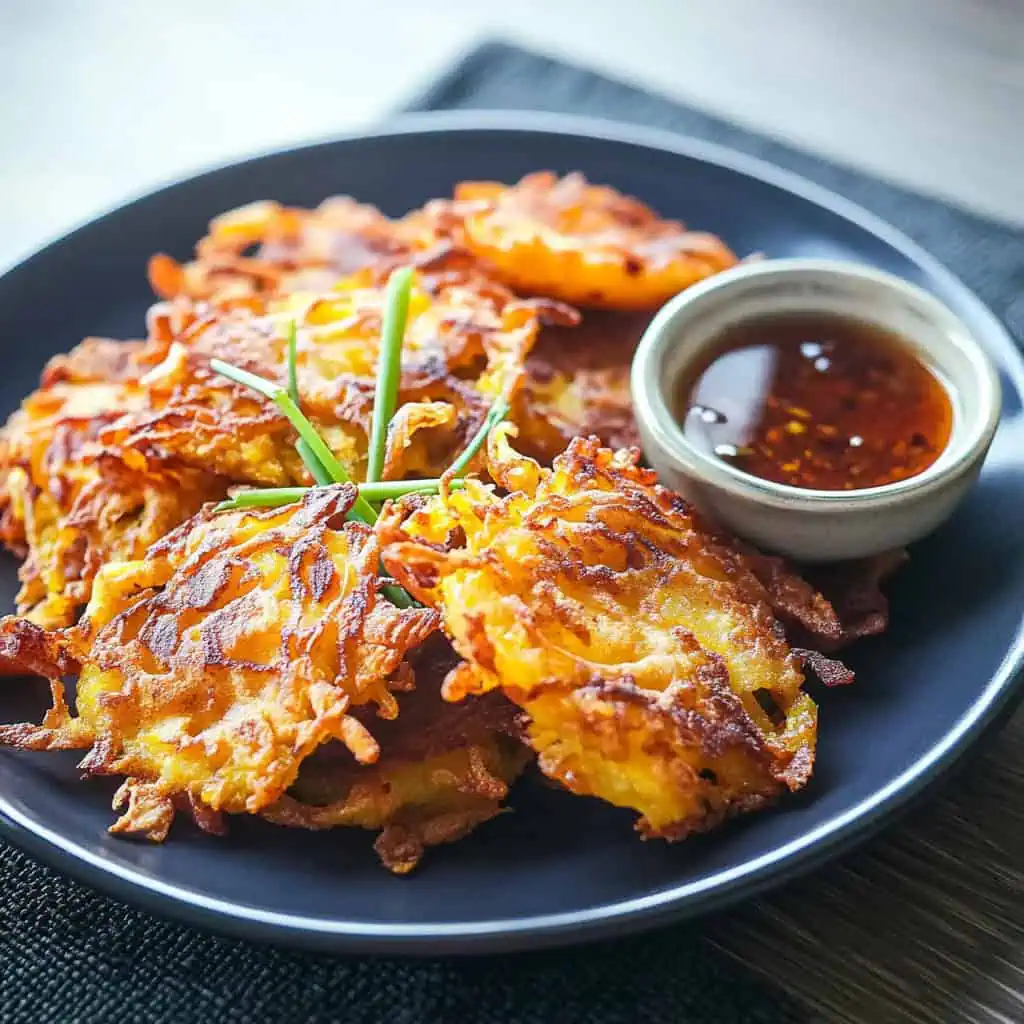
Why You'll Love This Recipe
- Budget-Friendly: A vegetarian twist on the traditional shrimp ukoy that's economical without compromising on flavor
- Crispy Perfection: Achieves the perfect balance of crispy exterior and tender interior
- Versatile: Works great as a side dish, appetizer, or afternoon snack
- Healthier Option: Packed with nutritious vegetables and can be air-fried for a lighter version
- Kid-Friendly: The natural sweetness of buttercup squash appeals to children
- Make-Ahead Friendly: The batter can be prepared in advance
Ingredients
This recipe showcases buttercup squash for its natural sweetness and ability to crisp beautifully when fried. Carrots add complementary sweetness and a pop of color, while spring onions and red onions provide savory depth.
The combination of all-purpose flour and cornstarch creates the perfect crispy coating, with eggs acting as a reliable binder. Cold water is crucial for achieving lightness in the batter, while fish sauce (or salt) delivers that essential umami flavor that makes these fritters irresistible.
The vinegar dipping sauce balances the richness with acidity and a hint of spice, creating a perfect harmony of flavors and textures that honors traditional Filipino cooking techniques while highlighting garden-fresh vegetables.
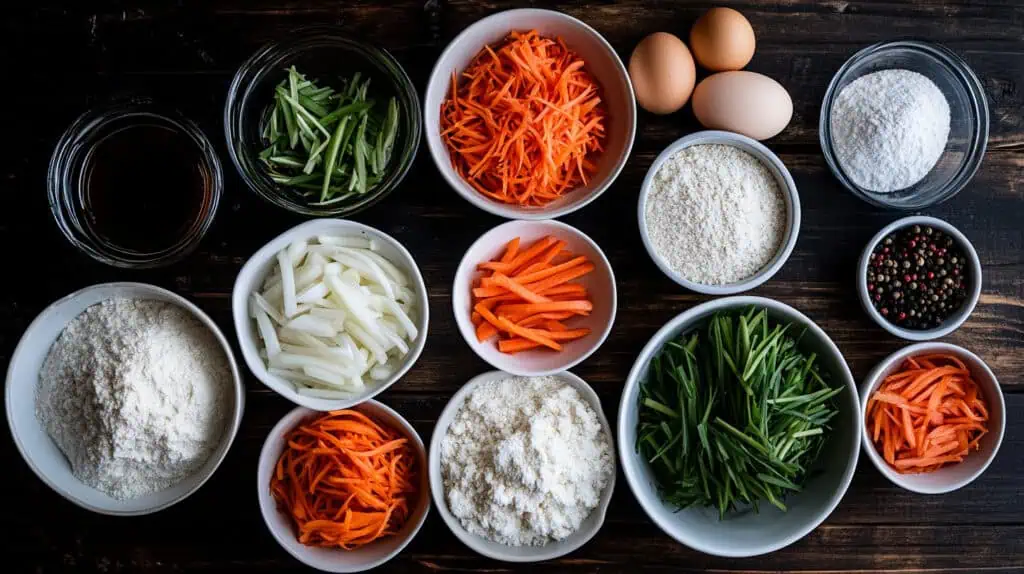
- 2½ cups buttercup squash, julienned
- ½ cup carrots, julienned
- ½ cup spring onions, sliced
- 1 red onion, thinly sliced
- 1 cup all-purpose flour
- ½ cup cornstarch
- 2 large eggs
- ⅔ cup cold water
- 2 tablespoons fish sauce (or sea salt for vegetarian option)
- 6 cloves garlic, minced
- Salt
- Freshly ground black pepper
- Oil for frying
For the Sweet and Spicy Vinegar Dip (Sawsawan):
- ½ cup white vinegar
- 2 cloves garlic, minced
- 1 small red chili, chopped
- 1 tablespoon sugar
- Salt to taste
Equipment
- Large Mixing Bowl: For combining all ingredients and creating a uniform batter
- Box Grater or Mandoline: Essential for julienning vegetables to the same thickness, ensuring even cooking and optimal crispness
- Heavy-Bottom Skillet: Provides even heat distribution for perfectly crispy fritters
- Spider Strainer: Allows you to gently remove fritters from hot oil while leaving excess oil behind
- Paper Towel-Lined Plate: Helps drain excess oil after frying for crispier results
- Measuring Cups and Spoons: Ensures accurate measurements for consistent results
- Temperature Probe (Optional): Helps maintain the ideal oil temperature of 350°F for perfect frying
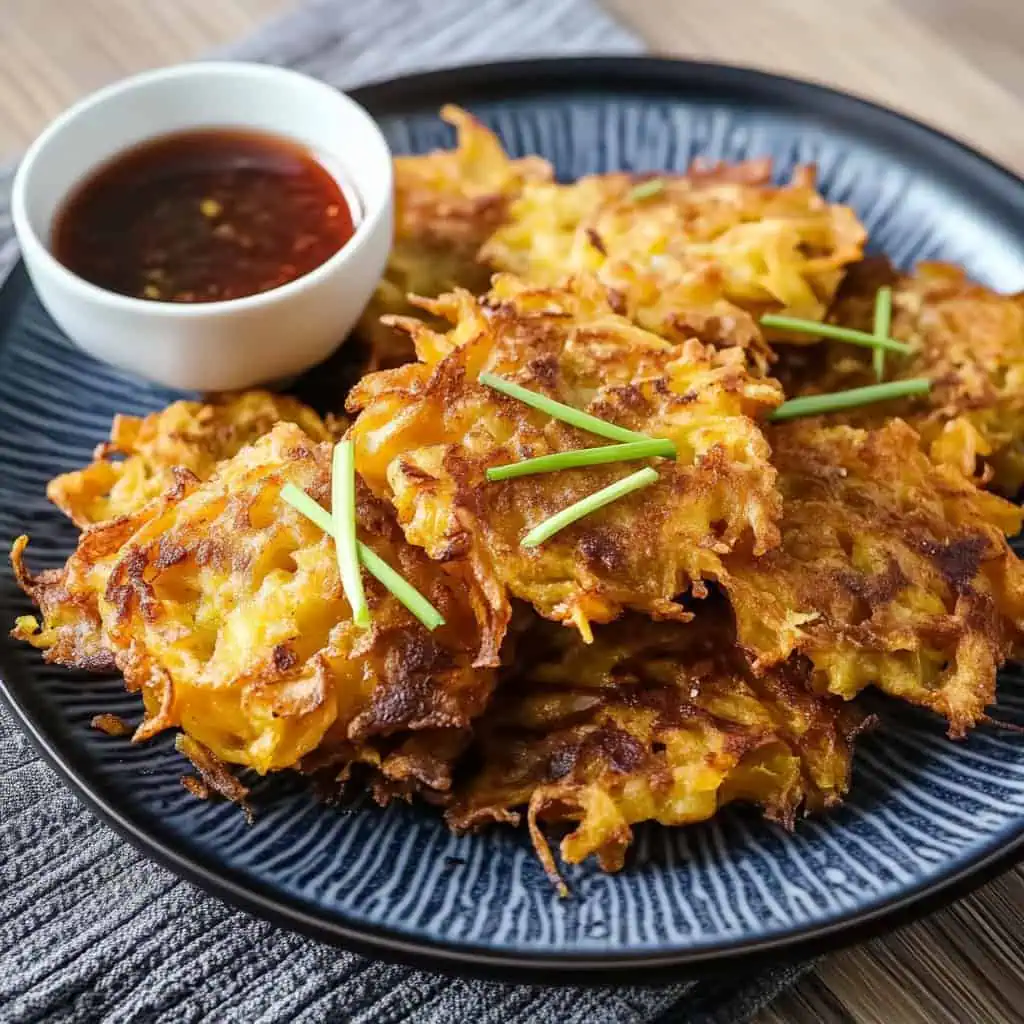
How To Make
- Begin by preparing your dipping sauce. In a small bowl, combine vinegar, minced garlic, chopped chili, sugar, and a pinch of salt. Set this aside to let the flavors develop while you make the fritters.
- Get your vegetables ready. Cut your buttercup squash and carrots into thin, matchstick pieces about 2 inches long. Slice your spring onions and red onion thinly. Pat all vegetables dry with a clean kitchen towel.
- Make your batter by whisking together flour, cornstarch, eggs, cold water, fish sauce, minced garlic, salt, and pepper in a large bowl until smooth. The batter should slowly drop from a spoon - if it's too thick, add cold water one tablespoon at a time.
- Add all your prepared vegetables to the batter. Gently mix everything until all vegetables are evenly coated.
- Heat oil in a heavy pan until it reaches 350°F (175°C). If you don't have a thermometer, drop a tiny bit of batter - it should sizzle and float immediately.
- Scoop ½ cup of the mixture for each fritter and carefully drop it into the hot oil. Quickly flatten it with your spatula until it's about ¼-inch thick.
- Fry each fritter for 3-4 minutes until the bottom turns golden brown and crispy. Flip once and cook the other side for another 3-4 minutes.
- Remove from the oil when both sides are crispy and golden brown. Place on paper towels to drain excess oil.
- Clean out any loose bits from the oil with a strainer between batches. Wait for the oil to get back to temperature before adding the next batch.
- Serve immediately while hot and crispy with your prepared dipping sauce. For the best experience, eat within 15 minutes of cooking when the ukoy is at its crunchiest.

Tips from Lola's Kitchen
- The Cold Water Secret: Always use cold water in your batter - this creates steam when it hits the hot oil, resulting in a lighter, crispier texture.
- Dry Vegetables Equal Crispy Fritters: Pat your julienned vegetables thoroughly with paper towels before adding to the batter. Excess moisture is the enemy of crispiness!
- Listen to Your Oil: A steady, gentle sizzle means your oil is at the perfect temperature. Too loud? Your oil is too hot. Too quiet? Your oil needs to heat up more.
- Consistent Cutting: Take your time julienning the vegetables to the same size - this ensures even cooking and the perfect texture throughout.
- Rest Between Batches: Allow your oil to return to 350°F between batches for consistently crispy results.
Substitutions
- No Buttercup Squash? Butternut squash works beautifully as a substitute with its similar sweetness.
- Vegetable Variations: Sweet potato (kamote) can replace up to half of the squash for a different flavor profile.
- Flour Alternatives: For even crispier results, replace the cornstarch with rice flour.
- Vinegar Options: Apple cider vinegar can be used in the dipping sauce for a milder flavor.
- Egg-Free Version: Replace eggs with 2 tablespoons cornstarch mixed with 6 tablespoons water for a binding effect.
Troubleshooting
- Fritters Falling Apart? Your batter may be too thin. Add a tablespoon of flour at a time until it reaches a thicker consistency.
- Not Crispy Enough? Either your oil temperature is too low or your batter is too thick. Thin it slightly with cold water.
- Fritters Too Dark? Your oil is likely too hot. Lower the heat and wait a minute before continuing.
- Soggy Centers? You're either making the fritters too thick or your vegetables contain too much moisture. Flatten the fritters more and be sure to pat vegetables dry.
- Oil Smoking? Turn down the heat immediately and wait for it to cool slightly before continuing.
Storage & Reheating
- Refrigeration: Store cooled fritters in an airtight container for up to 3 days in the refrigerator.
- Freezing Uncooked Mixture: The vegetable-batter mixture can be frozen for up to 1 month. Thaw completely before frying.
- Best Reheating Methods:
- Oven: Place on a wire rack over a baking sheet and heat at 350°F for 5-7 minutes for optimal crispiness.
- Air Fryer: Heat at 350°F for 3-4 minutes for results almost as good as freshly made.
- Avoid Microwaving: This will make your fritters soggy and ruin the crispy texture.

FAQ
Can I prepare this ahead of time for a party?
You can prepare the batter and vegetables separately up to 2 hours ahead, but only combine them right before frying for the best texture. Keep the cut vegetables in cold water to prevent browning, but dry thoroughly before mixing with batter.
Is this recipe vegan-friendly?
You can easily make it vegan by replacing eggs with a cornstarch slurry (2 tablespoons cornstarch mixed with 6 tablespoons water) and using sea salt instead of fish sauce.
How do I know when the oil is the right temperature without a thermometer?
Drop a small amount of batter into the oil – it should sizzle immediately and rise to the surface within seconds. If it sinks and barely bubbles, the oil is too cool. If it browns instantly, the oil is too hot.
Can I use other vegetables in this recipe?
Yes! Zucchini, sweet potatoes, and even bell peppers work well, but maintain similar ratios and ensure vegetables are dry and cut uniformly. Each vegetable will lend a different flavor profile.
How can I make these healthier?
For a lighter version, you can air fry these at 400°F for 12-15 minutes, turning halfway through. Spray with a little oil before cooking for better browning.
Related
Looking for other recipes like this? Try these:
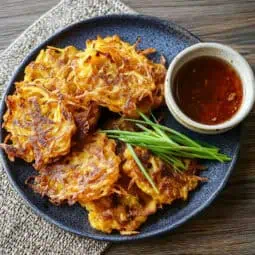
Kalabasang Ukoy (Filipino Squash Fritters)
Equipment
- Large Mixing Bowl (Malaking Mangkok): For combining ingredients
- Box Grater or Mandoline (Kahoy na Kudkuran): For julienning vegetables uniformly
- Heavy-Bottom Skillet (Kawali): Ensures even heat distribution for crispy results
- Spider Strainer (Sandok na May Butas): For removing fritters from oil
- Paper Towel-Lined Plate (Plato na may Paper Towel): For draining excess oil
- Measuring Cups and Spoons (Panukat): For accurate measurements
- Temperature Probe (Optional): For monitoring oil temperature
Ingredients
For the Fritters:
- 2½ cups buttercup squash julienned (kalabasa, hiniwa ng manipis)
- ½ cup carrots julienned (karot, hiniwa ng manipis)
- ½ cup spring onions sliced (sibuyas na mura, hiniwa)
- 1 red onion thinly sliced (pulang sibuyas, hiniwa ng manipis)
- 1 cup all-purpose flour arina
- ½ cup cornstarch cornstarch
- 2 large eggs itlog
- ⅔ cup cold water malamig na tubig
- 2 tablespoons fish sauce or sea salt for vegetarian option patis o asin
- 6 cloves garlic minced (bawang, dinurog)
- Salt asin
- Freshly ground black pepper paminta
- Oil for frying mantika
For the Sweet and Spicy Vinegar Dip (Sawsawan):
- ½ cup white vinegar suka
- 2 cloves garlic minced (bawang, dinurog)
- 1 small red chili chopped (siling labuyo)
- 1 tablespoon sugar asukal
- Salt to taste asin
Instructions
- Begin by preparing your dipping sauce. In a small bowl, combine vinegar, minced garlic, chopped chili, sugar, and a pinch of salt. Set this aside to let the flavors develop while you make the fritters.
- Get your vegetables ready. Cut your buttercup squash and carrots into thin, matchstick pieces about 2 inches long. Slice your spring onions and red onion thinly. Pat all vegetables dry with a clean kitchen towel.
- Make your batter by whisking together flour, cornstarch, eggs, cold water, fish sauce, minced garlic, salt, and pepper in a large bowl until smooth. The batter should slowly drop from a spoon - if it's too thick, add cold water one tablespoon at a time.
- Add all your prepared vegetables to the batter. Gently mix everything until all vegetables are evenly coated.
- Heat oil in a heavy pan until it reaches 350°F (175°C). If you don't have a thermometer, drop a tiny bit of batter - it should sizzle and float immediately.
- Scoop ½ cup of the mixture for each fritter and carefully drop it into the hot oil. Quickly flatten it with your spatula until it's about ¼-inch thick.
- Fry each fritter for 3-4 minutes until the bottom turns golden brown and crispy. Flip once and cook the other side for another 3-4 minutes.
- Remove from the oil when both sides are crispy and golden brown. Place on paper towels to drain excess oil.
- Clean out any loose bits from the oil with a strainer between batches. Wait for the oil to get back to temperature before adding the next batch.
- Serve immediately while hot and crispy with your prepared dipping sauce. For the best experience, eat within 15 minutes of cooking when the ukoy is at its crunchiest.
- Remember: Keeping your oil at the right temperature is key - not too hot, not too cool. You should hear a steady, gentle sizzle while frying.
Tips from Lola's Kitchen
- Use cold water in the batter for maximum crispiness
- Pat vegetables dry before mixing into batter to prevent sogginess
- Don't overcrowd the pan – leave space between fritters
- Listen for a steady sizzle – if too loud, oil is too hot; if too quiet, oil is too cool
- Julienne vegetables to the same size for even cooking
Nutrition
The Story Behind Kalabasang Ukoy
In the vibrant tapestry of Filipino street food culture, ukoy stands as a testament to the resourcefulness and culinary ingenuity of home cooks across the archipelago. While traditional ukoy, with its signature golden-brown shrimp peeking through crispy batter, remains a beloved fixture in local markets and street-side stalls, regional variations like Kalabasang Ukoy showcase the adaptability of Filipino cuisine to local ingredients and economic circumstances.
This vegetable-forward version emerged from the practical wisdom of provincial households, particularly during seasons when seafood was either scarce or prohibitively expensive. Buttercup squash, known locally as kalabasa, became a natural substitute not only for its availability in backyard gardens but also for its natural sweetness and ability to crisp beautifully when properly prepared. The tradition of growing kalabasa in home gardens dates back generations, with many Filipino households maintaining at least one squash vine that often becomes a community source of sustenance.
The transformation of ukoy from a shrimp-based fritter to this vegetable-centric version reflects the Philippine's agricultural heritage and the creative spirit of Filipino home cooks. While the exact origins of Kalabasang Ukoy aren't documented in formal culinary histories, oral traditions suggest it gained prominence during the post-war period when families needed to stretch their resources while maintaining the familiar textures and communal eating experiences that define Filipino food culture.
What makes this variation particularly noteworthy is how it maintains the essential elements that make ukoy beloved - the satisfying crunch, the complex interplay of flavors, and the social aspect of gathering around freshly fried batches with sawsawan for dipping. The recipe demonstrates how Filipino cuisine often finds its most innovative expressions not in high-end restaurants but in humble home kitchens where necessity breeds creativity.
Today, Kalabasang Ukoy has transcended its roots as a mere substitute to become a sought-after dish in its own right. As more people embrace plant-based eating or seek budget-friendly alternatives to traditional recipes, this version of ukoy perfectly aligns with contemporary dietary preferences while honoring the fundamental techniques and flavors of Filipino cooking. Whether served as merienda (afternoon snack) or as part of a larger meal, it represents the continuing evolution of Filipino cuisine while maintaining its deep connections to home, family, and community.
The enduring popularity of this dish also speaks to the Filipino value of "diskarte" - the ability to adapt and create something wonderful from whatever ingredients are available. In many ways, Kalabasang Ukoy embodies the sustainable, locally-sourced cooking practices that modern food movements advocate for, though Filipino cooks have been practicing these principles for generations through dishes exactly like this one.
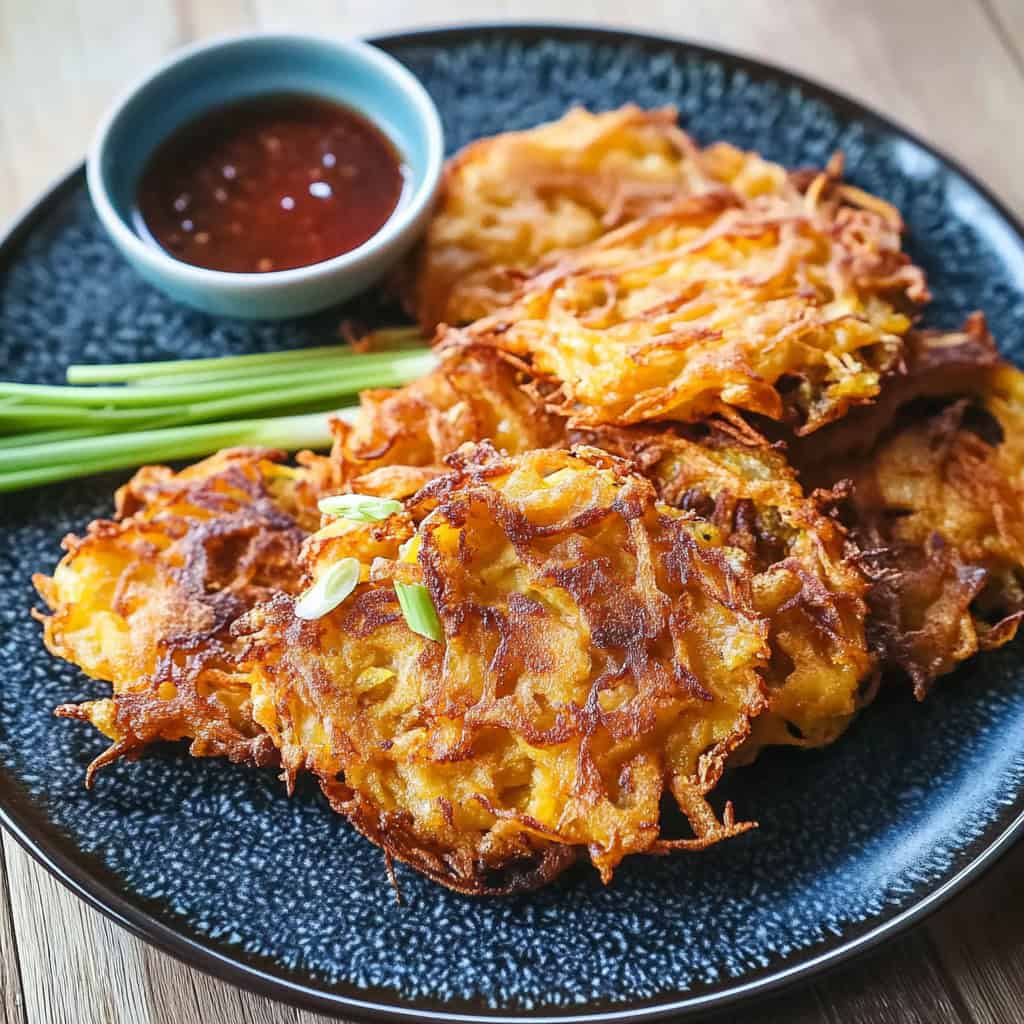









Comments
No Comments